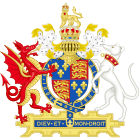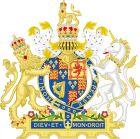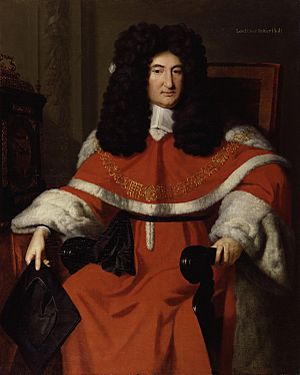Witchcraft Acts facts for kids
The Witchcraft Acts were a series of laws in England, Scotland, Wales, Ireland, and British colonies. These laws made it illegal to practice witchcraft or, in later years, to pretend to practice it. The punishments for breaking these laws were very serious.
Contents
The Witchcraft Act of 1541
| Act of Parliament | |

|
|
| Long title | An Act against Conjurations, Witchcrafts, Sorcery and Inchantments. |
|---|---|
| Citation | 33 Hen. 8. c. 8 |
| Dates | |
| Repealed | 1547 |
|
Status: Repealed
|
|
During the 1500s and 1600s, there was a lot of religious tension in England. This led to very harsh punishments for witchcraft. In 1541, King Henry VIII created the first law that called witchcraft a felony. A felony was a serious crime that could be punished by death. People found guilty would also lose all their belongings.
This law also took away the "benefit of clergy." This was a rule that sometimes protected accused people from being tried in the King's courts. This meant that people accused of witchcraft could no longer use this protection. However, Henry's son, Edward VI, cancelled this law in 1547.
The Witchcraft Act of 1562
| Act of Parliament | |

|
|
| Long title | An Act Against Conjurations, Enchantments and Witchcrafts. |
|---|---|
| Citation | 5 Eliz. 1. c. 16 |
| Other legislation | |
| Repealed by | Witchcraft Act 1604 |
|
Status: Repealed
|
|
| Text of statute as originally enacted | |
Queen Elizabeth I passed a new law in 1562 called An Act Against Conjurations, Enchantments and Witchcrafts. This law was a bit kinder than the earlier one. It only demanded the death penalty if someone was harmed by witchcraft. For less serious witchcraft acts, the punishment was imprisonment.
The law stated that anyone who used "Witchcraft, Enchantment, Charm, or Sorcery" to kill someone would be put to death. They would not get the "benefit of clergy." After this law was passed, records show more cases where people were accused of killing others with witchcraft. About 20% of all murder victims in records were thought to have been killed by witchcraft. Only about half of those accused were found guilty. Most of the accused were women, with only a few men.
The Scottish Witchcraft Act of 1563
In Scotland, the Witchcraft Act of 1563 made it a crime punishable by death to practice witchcraft or even to talk to witches. This law stayed in place in Scotland for a long time. It was finally cancelled in 1735 when a new law was passed for all of Great Britain.
The Irish Witchcraft Act of 1586
The Irish law, passed in 1586, was very similar to the English law of 1562. If someone caused death by witchcraft, the punishment was death. If someone caused injury or loss of property with witchcraft, the first time they would go to prison for a year. They would also spend six hours in a pillory (a device that held a person's head and hands) once every three months. A second offense meant death.
Using witchcraft to find hidden treasure, stolen goods, or to make someone fall in love was also punished. The first time, it was a year in prison and time in the pillory. A second time meant life in prison.
The last time someone was tried under this law was in 1711, during the Islandmagee witch trial. It is not known for sure if anyone was actually executed under this Irish law. For example, Florence Newton died during her trial in 1661. The law was finally cancelled in 1821.
The Witchcraft Act of 1604
| Act of Parliament | |

|
|
| Long title | An Act against Conjuration, Witchcraft and dealing with evil and wicked spirits. |
|---|---|
| Citation | 1 Jas. 1. c. 12 |
| Other legislation | |
| Repeals/revokes | Witchcraft Act 1562 |
In 1603, when King James I became king of England, the witchcraft law became even stricter. This new law, called An Act against Conjuration, Witchcraft and dealing with evil and wicked spirits, made it a death penalty crime to call upon evil spirits or talk to "familiar spirits" (like animal helpers believed to be linked to evil). This was a felony, meaning no "benefit of clergy" was allowed.
This law was used by people like Matthew Hopkins, who called himself the "Witch-Finder General." He was famous for finding and accusing witches. Under these new laws, people accused of witchcraft were tried in regular courts, not church courts. This meant they had some basic legal rights. Most people found guilty were hanged, not burned at the stake. If someone committed a small witchcraft offense and was caught a second time, they would be sentenced to death.
Use in Colonies
The Witchcraft Act of 1604 was also used in the British colonies in America. For example, it was used in the trial of Margaret Mattson in Pennsylvania. She was accused of witchcraft in 1683 but was found not guilty by William Penn.
The Scottish Witchcraft Act of 1649

In the 1640s, church leaders in Scotland pushed for the witchcraft laws to be used more strictly. In 1649, a new Scottish witchcraft act was passed. It confirmed the 1563 law and also made it a death penalty crime to consult with "Devils and familiar spirits."
The Witchcraft Act of 1735
The Witchcraft Act of 1735 showed a big change in how people thought about witchcraft. By this time, many important people believed that witchcraft was not real. So, this new law no longer punished people for actually practicing witchcraft. Instead, it punished people for pretending to have magical powers.
If someone claimed they could call up spirits, tell the future, cast spells, or find stolen goods, they would be treated as a con artist or a homeless person. They could be fined or sent to prison. This law applied to all of Great Britain. It cancelled both the 1563 Scottish Act and the 1604 English Act.
The Witchcraft Act of 1735 stayed in force in Britain for a very long time, even into the 1900s. It was finally cancelled in 1951 by a new law called the Fraudulent Mediums Act 1951. This 1951 law was then cancelled in 2008 by new rules about fair sales and marketing.
Other Related Laws
- The Witchcraft Suppression Act, 1957 in South Africa is still in use today. It was based on the Witchcraft Act of 1735.
- The Massachusetts Bay Colony also passed a law against witchcraft in October 1692.
See also
- Bideford witch trial: The trial of the last three people known to have been executed for alleged witchcraft in England, in 1682.
- Janet Horne: The last person legally executed for witchcraft in the British Isles, in 1727.
- Helen Duncan: The last person sent to prison under the Witchcraft Act 1735, in April 1944. Her case helped lead to the law being cancelled.
- Jane Rebecca Yorke: The last person found guilty under the Witchcraft Act 1735, in September 1944. She was fined for her actions.
- Margaret Mattson: A woman accused of witchcraft in the Province of Pennsylvania. She was found not guilty by William Penn in 1683.

